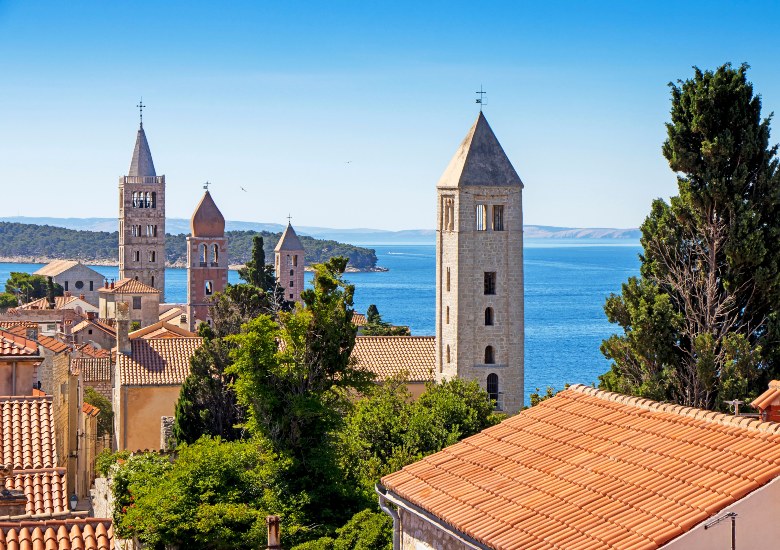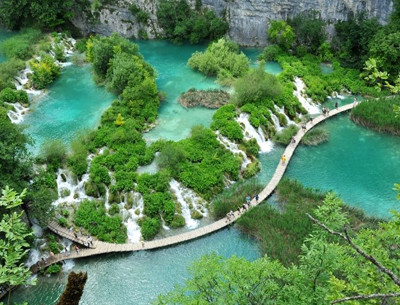Where to Go After Your Dalmatian Coast Cruise
On your Dalmatian coast cruise, you’re likely to visit coastal cities on the mainland like Split and Dubrovnik while island-hopping in between, perhaps to Hvar, Korcula, Vis, and Mljet. But while you’re in Croatia, why not take advantage of some of the many other enticing destinations the country has to offer? There are also outstanding spots in neighboring countries, including Montenegro, Slovenia, and Italy, allowing you to see more in one trip. Whether you’re a wine enthusiast, a foodie, a history buff, or an outdoor adventurer, there’s something for you within easy reach. When it comes to where to go after your Croatia cruise, these are some of the top to consider for an especially memorable experience.
Istria is often compared to Tuscany without the crowds, home to picturesque hilltop villages like Motovun, surrounded by olive groves, vineyards, and dense forests where truffle hunters and their dogs search for the rare delicacy. Visitors can even take a tour to join them, learning how it’s done and enjoying samples. The town itself hosts many little shops selling truffle items and restaurants often feature truffle dishes. In the city of Pula, one can wander the labyrinth of pedestrianized alleyways and discover a 1st-century AD Roman amphitheater, the Pula Arena. Romantic Rovinj has an impeccably preserved Old Town with its crown jewel the Baroque-style Church of Saint Euphemia and its 200-foot-high campanile. Climb to the top for a spectacular panoramic view.
Croatia’s largest and most famous national park, Plitvice is one of the top places to visit on a Croatia vacation with its stunning 16 interconnected lakes in brilliant shades of emerald and turquoise. Countless waterfalls are laced in between while vibrant greenery enhances the natural beauty even more. There are wooded paths and little bridges, boardwalks, a panoramic “train” and electric boats that make it easy to explore both the Lower Lakes and Upper Lakes sections. Don’t miss Veliki Slap or “Great Waterfall,” the tallest waterfall in the country, plunging 256 feet. Along the way, be sure to keep an eye out for the diverse flora and fauna, including brown bears, grey wolves, lynx, the smallest European owls, eagles, and hawks.
Zagreb is Croatia’s capital and largest city, located along the River Sava. It offers an excellent blend of old and new, distinguished by its 18th- and 19th-century Austro-Hungarian architecture. You’ll find lots of public art, lovely parks, street food, and outdoor cafes along with historic landmarks. The Upper Town at its heart is home to the Gothic-style, twin-spired Zagreb Cathedral and 13th-century St. Mark’s Church with an iconic colorful roof. The main square is in the Lower Town, known for its excellent shopping and dining with secessionist, Baroque, and Art Deco buildings. To mingle with the locals, join the špica, a Saturday morning ritual of taking to the pedestrianized streets between Petar Preradović and Ban Jelačić squares to sip coffee while socializing.
The Kvarner Gulf is tucked between Dalmatia to the south and the Istrian peninsula to the north. It’s known for its charming fishing villages with narrow alleyways and lush gardens with subtropical plants. Rijeka is the largest port and a gateway to islands such as the easily accessible Krk, linked by a road bridge. The biggest island in the Adriatic, visitors can enjoy everything from discovering ancient history to scuba diving, sunbathing, and sampling the delicious local fare. Cres, Rab, and Losinj can all be reached by ferry, offering a laid-back atmosphere, beautiful coves and beaches, and some enticing historic towns. Losinj is ideal for blissful relaxation with crystal-clear turquoise water for swimming, aromatic pine forests, medicinal herbs, and eucalyptus and lemon trees.
Zadar is Croatia’s oldest continuously inhabited city with a history dating back over 3,000 years. Some of the highlights include the 1st-century BC Roman forum, the 9th-century St. Donat’s Church with its unusual cylindrical shape, and defensive walls built in the 16th century. To learn more about its past, explore the Archaeological Museum with artifacts spanning from prehistoric times through the 15th century. The city’s modern side includes a famous pair of art installations along the waterfront, with the Sea Organ using the power of waves to make music and the Greeting to the Sun playing a light show. Zadar is also a gateway to Kornati National Park which includes 90 unspoiled islands in the Kornati archipelago boasting unrivaled natural beauty.
Kotor and Perast are within a two-hour drive of Dubrovnik, easily doable on a day trip. Kotor is nestled in fjord-like Kotor Bay and boasts a UNESCO-listed Old Town encircled by roughly 2.8-mile-long medieval walls. Discover historical landmarks like the Clock Tower in the main square, built in 1602 with two large clocks and a bell ringing every 30 minutes. Other highlights include majestic palaces and the Romanesque St. Trypon Cathedral, a masterpiece with Baroque bells dating to 1166. Perast is one of the prettiest little towns in Kotor Bay, home to 16 magnificently preserved palaces. Its most popular attraction is reached via a quick boat ride, the man-made islet of Our Lady of the Rocks, topped with a church and museum.
One of the most popular answers to where you should go after your Dalmatian Coast cruise is Venice, which can be reached by ferry from the town of Rovinj on Croatia’s Istria Peninsula in about 3.5 hours. One of the world’s top destinations, St. Mark’s Square sits at its heart. It’s home to St. Mark’s Basilica with stunning marble pillars, mosaics, and a bell tower that can be climbed for a panoramic view, along with 14th-century Venetian-Gothic Doge’s Palace, and the Torre dell’Orologia clock tower, one of the finest examples of Venetian architecture. No first-time visit would be the same without a gondola ride along the picturesque canals. You’ll also want to sample the mouthwatering culinary scene with fresh seafood in abundance.
With many fairytale-like scenes, Slovenia is also well worth visiting on your Croatia vacation. The capital city of Ljubljana is less than a two-hour drive from Zagreb, with its Old Town the top attraction. A river runs through, crossed by charming bridges, while Ljubljana Castle sits on Castle Hill providing postcard-perfect photo ops. The castle is home to a historical museum, a puppet museum, and a lookout tower for a spectacular view over the city. From here, Lake Bled, beautifully backed by the Julian Alps, is only a 45-minute drive away, renowned for its sapphire waters with a little island in the middle, home to Our Lady of the Lake Church which can be reached via a traditional pletna boat.



























